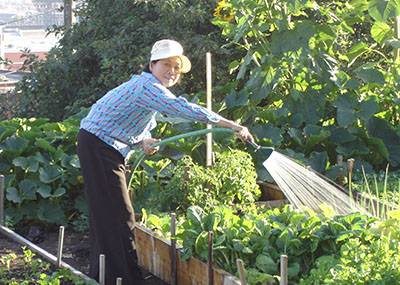Smart Watering

Water early or late in day to conserve water.
Watering too much causes many common plant problems. You can grow healthier, deeper-rooted plants, save money on water bills, and conserve precious water by learning to give your lawn and garden just what they need, and no more. Start with these key tips from the Smart Watering Guide (pdf).
Water deeply, but infrequently
Most plants do best if the soil is allowed to partially dry out between waterings. For lawns, a loss of shine or footprints showing indicate that it’s time to water. Vegetables and other annuals should be watered at the first sign of wilting, but tougher perennials (plants that live several years) only need water if they stay droopy after it cools off in the evening. Trees and shrubs usually don’t need any watering once their roots are fully established (two to five years), except in very dry years.
Moisten the whole root zone
Watering deeply builds deeper, healthier root systems. To see if you are watering deep enough to moisten the whole root zone, dig in with a trowel an hour after watering to check the depth.
Make every drop count
Some easy ways to lower water bills and get more water to plants include:
- Mix compost into your soil, and spread mulch on top of soil to hold more water and prevent evaporation.
- Choose low water use plants. Once established they can often thrive just on rainfall.
- Use soaker hoses or drip irrigation on beds – they save 50% or more compared with sprinklers!
- Use a timer that screws onto the faucet (available at garden stores) to water just the right amount.
- Water lawns separately from other plantings. Make sure sprinklers aren’t watering the pavement too.
- When soil is dry or compacted it won’t absorb water quickly. If water puddles, stop watering for a while and then restart, so the water has time to soak in.
- Water in the early morning or evening – if you water at mid-day, half of the water just evaporates.
Use automatic irrigation systems efficiently
Automatic systems often waste a lot of water, or they can be fairly efficient depending on how you set and maintain them.
- Have a professional test, repair, and adjust your system annually.
- Inspect the system while operating once a month – look for leaks or heads that are plugged or misdirected.
- Install a rain shutoff device (ask your irrigation expert where to find them).
- Adjust the watering schedule at least once a month through the season – plants need a lot less water in May and September than they do in July and August.
Learn more
Smart Watering (pdf) - This guide will help you plan your yard to use water efficiently.
Get to Know Your Soil (pdf) - Solve soil problems, and determine how long and how often to water to grow deeper-rooted and healthier plants.
How to Water New Plants - Learn how to get your new plants off to a healthy start.
Soaker Hose Instructions (pdf) - Save water, money and time by installing and using soaker hoses.
The Plant List (pdf) - 240 great plants for our region: most are drought tolerant, many natives.
Related Links
Rebates & Tips for Irrigation Systems - Tips to set and maintain your automatic irrigation system, and rebates for water-saving upgrades.
Links to Other Sites
Saving Water Partnership - Great ideas and rebates for water conservation in your home, yard, school, or business.